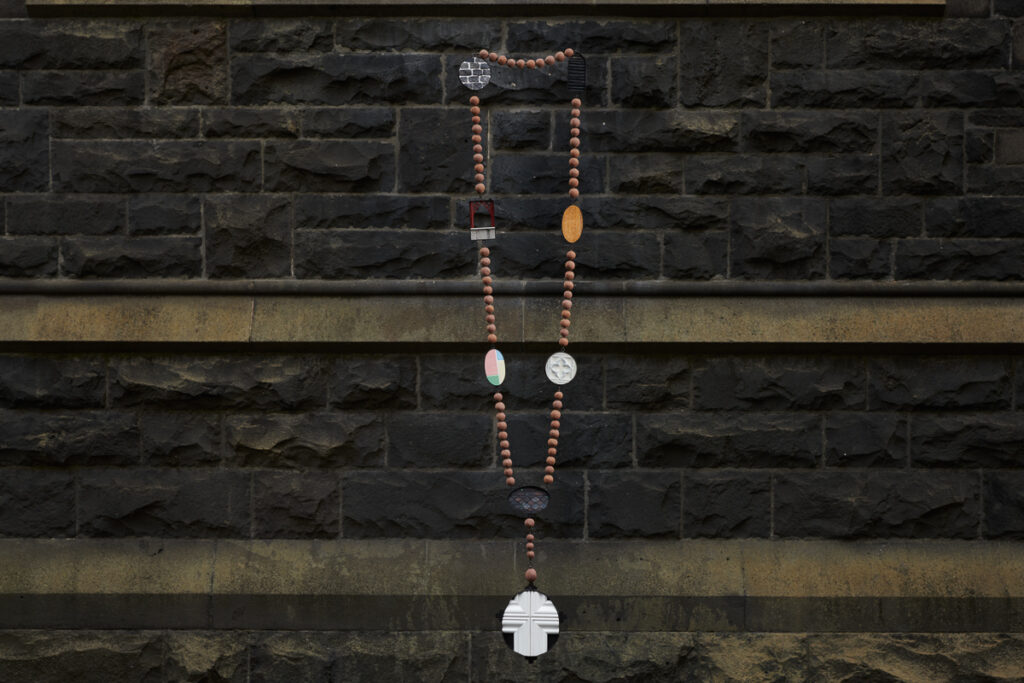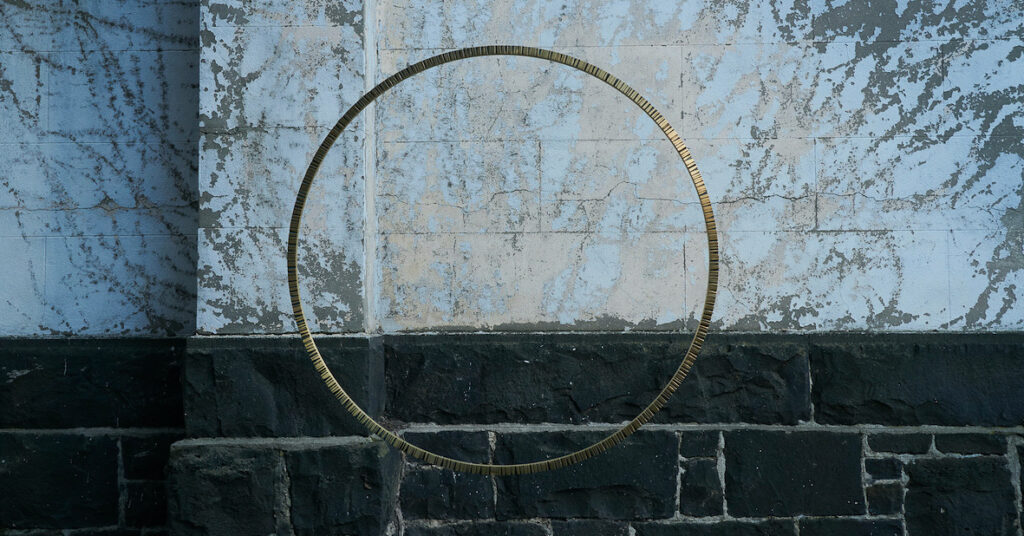Marian Hosking introduces a jeweller who honours those who sustained the historic nunnery where she works, featuring a rosary for one of its restorers.
Katheryn is an artist with over 15 years experience. As a contemporary jeweller, she is well versed in the possibilities, processes and traditions of Jewellery. Contemporary jewellery can be a cultural artefact, a signifier of identity, a marker of a celebration, such as birth, marriage and death. It can be a talisman, a political statement it can address current issues. It can be precious, but precious can be about what we value and hold dear. Above all, jewellery is an art form on a human scale.
I want to address works in this exhibition that challenge our sense of scale in response to the human body.
As you enter New Day, Narratives from the Convent, the first cabinet contains a miniature corridor, a colonnade of arches, finely, precisely crafted in steel, salvaged here from restoration work. As we stoop to view we can all imagine ourselves and past generations walking through this colonnade of arches; the girls, the Nuns who once inhabited this Convent building, the current creatives and the general public. It draws us into the gallery spaces and this wonderful exhibition. But then to realise that these architectural doorways are also individual earrings is such a nice surprise, the shift from miniature doorways to human adornment is a quality that reoccurs several times in this exhibition.
Selah – Pool of reflection invites us to pause and reflect. Looking into its dark depths we can see ourselves reflected in the surface of the water with a halo. The architectural quatrefoil is submerged and suspended beneath the surface. This inside or outside pond is scaled and positioned for viewing it is a mirror we complete its intention.
Wiki tells me a “quatrefoil” is a decorative element consisting of a symmetrical shape that forms the overall outline of four partially overlapping circles of the same diameter. The architectural aspect is evident throughout these buildings.
The impossible Almond branch with its buds and young almond fruit is a beautiful lifesize wearable work that suggests potential and growth. It is impossible not only because it is cast in bronze but for capturing various seasons and points of growth on one stick. It is Katheryn’s tribute and acknowledgement of her years here at the convent, enabling her to develop and grow the make and interact with the public and other creative people. This bronze branch will not easily decompose it has strength and vitality. I like many here today know the value and importance to of having a space in which to work and interact with other makers and creative people after graduating from art school or university. Katheryn has certainly benefited from her time here and established herself as a successful visual artist and contemporary jeweller.
The juxtaposition of scale in the Round table is exquisite. The clever resurfacing of familiar objects in a real scale table, glasses and bottles reduced to static still life with the vibrant internally lit miniature convent building upside down beneath. It is a thought-provoking work that is a testament to the five people who fought so hard, talked and met regularly, determined to save this building and its surrounds for the local people and the whole community. They conceived the idea of utilising the buildings, to house creative makers and artists including exhibition spaces and restaurants. It is this grassroots action that has enabled Katheryn and many others to establish themselves as professional artists in a creative and productive environment.
Teardrops and shadows appearing to drip onto the meadow, below, a new season, is such a clever reuse of materials salvaged from convent restoration combined with silver and acrylic. The teardrop shapes echo the petals on the flowers strewn below. A field of flowers, a new growth beyond the convent buildings. This is a rich and enchanting composition. The body re-emerges when the falling drops are attached to the body. The two parts of each drop are worn so the shadow is behind the lobe of the ear. The teardrops are joined in the centre to form the flowers.
The most poignant piece for me has to be the daisy chain. When I came to see the exhibition as Katheryn was setting up. In the darkened room behind me with only adjacent lighting, the daisy chain hovered over the scattered fallen petals. Each daisy is so beautifully executed in silver with such attention to detail. The fallen petals that can again be attached to an ear as a petal earring, I, like so many of you here today have sat amongst those African daisies popping up amongst the grass in our garden or public park, or maybe a daisy bush. Sat perhaps with a friend, a sibling or a grandchild, And picked a bunch, split the stem and threaded the daisy through the hole seeing how long you can make the chain. It becomes a necklace, a garland a celebration. But we also become aware of hope and loss when viewing this work. the sense of loss or maybe hope as we see the single petals scattered. To pluck the petals from a daisy, assisting us to answer a simple question: Yes, no, he loves me he loves me not. Childhood games, the petals representing the 111 years this convent housed orphaned and abandoned girls.
Although Katheryn has made work that responds directly to her years here at the convent and the people past and present, these installations have a much wider reading.
We should all take an interest in our local environment and work with friends and colleagues to build creative and beautiful public spaces.
Vic’s Rosary

Katheryn Leopoldseder, Necklace, Yarra clay, thread, copper, sterling silver, tin, salvaged tile & wood from the Convent, mortar, stone, paint, patina, 1500 x 500 x 30mm, photography & video: Fred Kroh, Abbotsford Convent, audio: Katheryn Leopoldseder
Katheryn Leopoldseder writes about Vic, one of the restorers at Abbotsford Convent.
Beads formed from clay harvested from the Yarra acknowledge the land pre-settlement. Taking the form of a rosary, where groups of beads symbolise a decade. Set like gems, the necklace is punctuated by salvaged building materials and architectural vignettes.
Vic’s Rosary takes its name from a builder with a long association with this place. Having first worked here during his apprenticeship in his teens when it was an active convent. Returning in his late seventies to carry out heritage restorations.
I’ve always loved discovering different architectural details around the Convent.
They appeal to me as a craftsperson.
The idea for Vic’s Rosary came because years back I met a smiling man who was part of a team of builders working on the heritage restorations here. Vic stood out because he was well into his seventies, was super fit and carried an enthusiasm for both his own craft and that of the creative community here. Always checking in to see how my projects were going and quick to lend a hand.
From time to time, he would retire. Popping back, not long after, in his overalls, having found the quiet life too frustrating.
Over time I heard that Vic had first learnt his trade as an apprentice builder here when he was a teenager. He would have been one of the few men allowed within this closed community.
I often think about crafted objects as embodied time, and how attaining the skills to create is an act of ongoing discipline and devotion.
In thinking about a piece that could honour those things, symbolised by Vic’s life, I came to learn that a rosary is a wearable tool for prayer and reflection. Traditionally the clusters of small beads represent a decade, while the larger beads between, represent significant events to meditate on.
For the Rosary beads, I harvested the clay from the Yarra, acknowledging the land.
Dotted around the necklace and set into bezels are architectural vignettes and pieces of re-purposed building materials that have been salvaged from the Convent.
Some examples of these are the fragments of gelato-coloured tiles, which come from the bathrooms in Sacred Heart. They reflect a cultural shift. Where the nuns moved towards a more contemporary architectural style, hoping to connect with the young women under their care.
A bezel-set section of salvaged wood refers to the timbers you find in the Linen Rooms, that were hand stained to take on the appearance of woodgrain. A paved bluestone element speaks of the Good Shepherd Chapel, convent paths and the bluestone quarries that used to be in this area.
Vic’s Rosary is an ode to material knowledge and the dedicated practice of craftsmanship over time.
Katheryn Leopoldseder, New Day, 16 March – 3 April 2022, The Store, Abbotsford Convent.
Visit https://www.leopoldseder.com.au/ and follow @katherynleopoldseder.
 Drawing Out the Gold – A Crown of Alfalfa by Katheryn Leopoldseder
Drawing Out the Gold – A Crown of Alfalfa by Katheryn Leopoldseder
The Melbourne jeweller Katheryn Leopoldseder manages to make epic statements out of personal adornment. Here she pays homage to a Mexican scientist was able to develop alfalfa as a non-toxic form of gold-mining.


